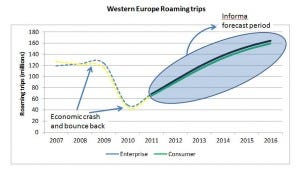Roaming forecast trends – short term economic anomaly versus long term trend
Having developed models and published forecasts for some time I am often intrigued by the way people read information. For some reading and interpreting data is a simple task but for many of us it is an impenetrable mist punctuated by mysterious terms like multi-point regression, Gompertz and sigmoid functions. Within such an environment forecasting begins to live up to its reputation as a dark art.
October 16, 2012

By Paul Merry
Having developed models and published forecasts for some time I am often intrigued by the way people read information. For some reading and interpreting data is a simple task but for many of us it is an impenetrable mist punctuated by mysterious terms like multi-point regression, Gompertz and sigmoid functions. Within such an environment forecasting begins to live up to its reputation as a dark art.
Analysts can be equally blasé in their assumptions based around reader’s comprehension of data. In the process of immersing themselves into a topic an analyst can sometimes over estimate readers pre-existing knowledge. A recent example of this occurred when a number of our customers requested clarification regarding our latest iteration of roaming forecasts. The particular question that arose was why we saw growth over the forecast period when the world was in the grips of an extreme economic downturn combined with large-scale fall-off in global travel, and in particular why growth was so strong in Western Europe.
The explanation is relatively simply but only when seen in the context of the adage that long term trends are always a better indicator than short. The key here is to see the growth in roaming as an indication of a return to pre-downturn levels rather than new growth, although there is a degree of this in this example.
The return to stability is a reflection of a concept called bounce-back, an effect commonly seen with share prices in which a crash invariable sees a steep bounce back when price hits a particular base price point – this phenomenon is also seen in the opposite direction with share hikes and corresponding falls. This volatility becomes less of an issue when the share price is considered over the longer-term. Volatility is effectively removed when considered over the long-term as the trend line is smoothed; the long term trend is revealed. Obviously a long-term trend is a better indicator for investing as it reduces the risk and impact of volatility in the market.
Bounce back is best understood in the context of roaming by looking ‘beyond’ our roaming forecasts.
Western European Consumer and Business Roaming Trips* – 2007-2016 (click to enlarge)

*A roaming trip is a trip in which a roaming event takes place (voice call, SMS or data service event)
Source Informa Telecoms and Media 2012 ©.
The chart above shows the period before the forecasts considered in our Global Roaming Forecasts 5th Edition as well as the period covered by the forecasts themselves (we also have data beyond the forecast period but let us save that for another day). It is evident when viewing the data that the growth shown over the forecast period (as marked) is more complex than a simple period of growth rather looking across the entire period it is a return to pre-downturn levels. This anomaly can be best understood by looking at the CAGR for the forecasts period of 19 per cent then comparing the period 2007-2016 figures which come out at a 3 per cent CAGR. By looking over this extended period the long-term trend becomes evident showing that actual growth is quite cautious.
Detractors might argue that roaming should still not grow over the long-term but a number of factors have combined to make this conjecture unlikely most important of which is the price capping regulation seen in Europe. This legislation will lead to experimentation and an increase in the volume of roaming trips or trips in which a roaming event takes place. This is particularly important in the consumer environment as this is an underpenetrated segment while the uptake in data capable devices, application stores, explosion in social media and data price caps will assist in the uptake of data roaming. When the combined effect of these paradigm shifting market developments is considered the 3 per cent CAGR over 2007-2016 becomes quite conservative and certainly not run-away growth.
This example shows how easy it is to see data in two completely different and diametrically opposite ways. It also demonstrates the complexity in forecasting the roaming market and the necessity of an approach that considers the market in immense detail a process we at Informa Telecoms and Media understand only too well.
Follow further machinations on this topic and many others on my twitter @PaulMerry1.
Read more about:
DiscussionYou May Also Like








.png?width=300&auto=webp&quality=80&disable=upscale)


_1.jpg?width=300&auto=webp&quality=80&disable=upscale)